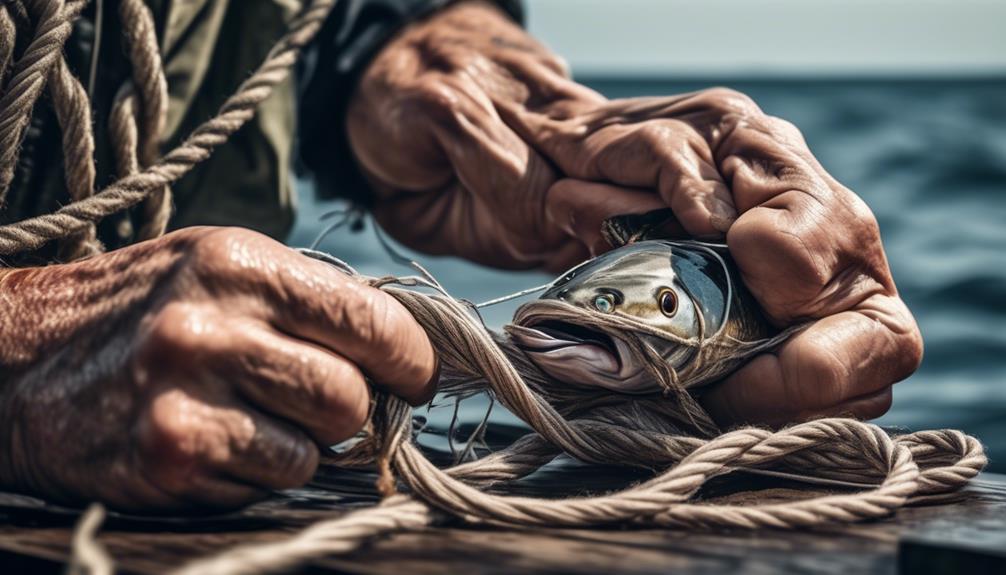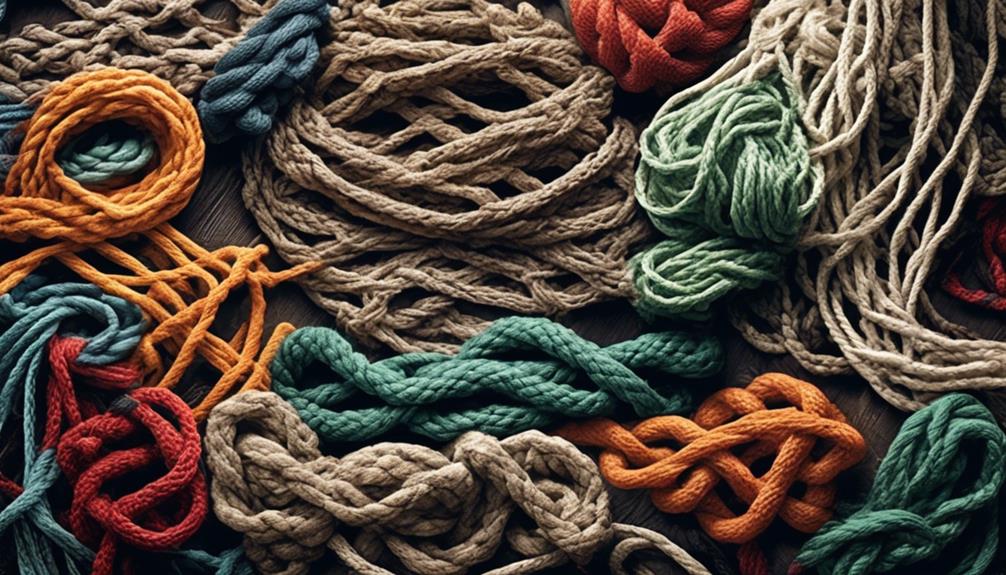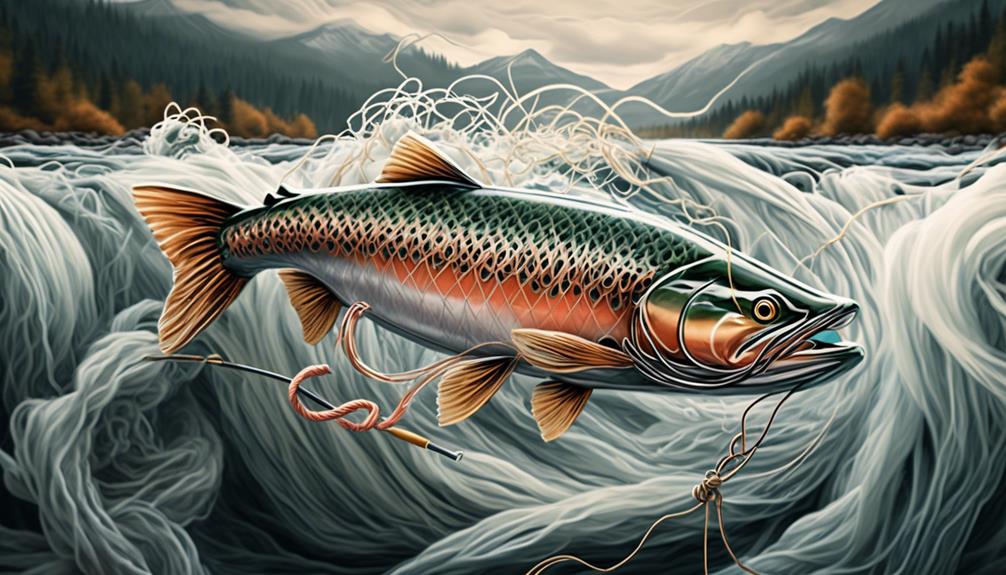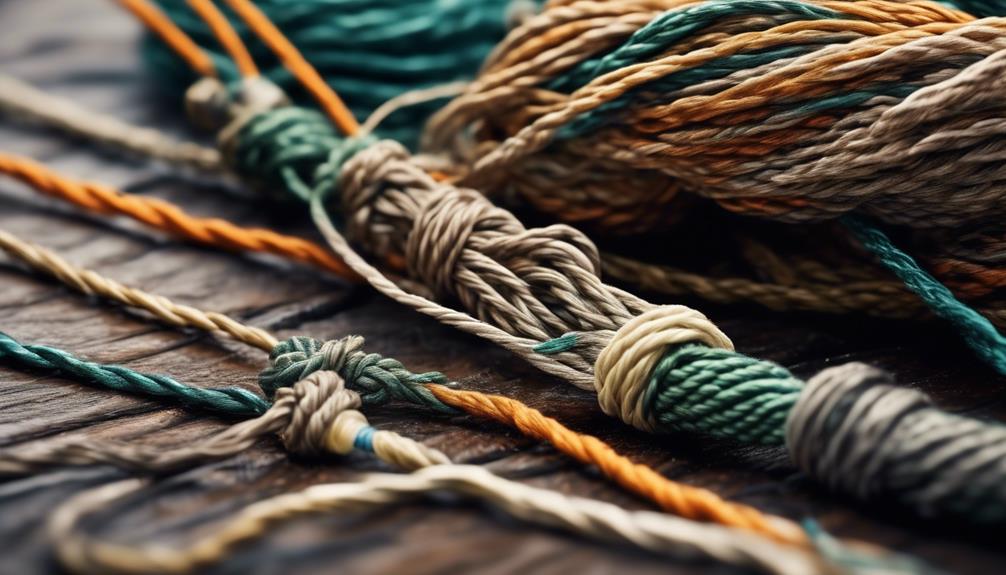When it comes to reeling in heavyweight fish, having the right fishing knot is like having a sturdy anchor in the stormy sea. You need something that can withstand the force and pull of a big catch without giving way.
But with so many knots out there, how do you know which ones are the strongest and most reliable? Well, lucky for you, we've compiled a list of the top fishing knots that are built to handle the toughest battles with the biggest fish.
So, if you want to ensure that your line holds firm when the big one bites, you'll want to keep reading.
Palomar Knot
The Palomar Knot is widely recognized as one of the strongest and most reliable fishing knots. Its simplicity and strength make it a favorite among anglers. One of the main advantages of the Palomar Knot is its ability to retain almost the full line strength, making it ideal for both monofilament and braided lines.
This knot is also easy to tie, even in low light conditions, which is a significant advantage when fishing at dawn or dusk. However, the Palomar Knot may not be the best choice for attaching small flies or lures, as its double line can impede the action of the bait. Additionally, it isn't recommended for lines over 20 pounds as the double line through the eye of the hook may cause complications.
To tie the Palomar Knot, double about 6 inches of line and pass it through the eye of the hook. Tie a simple overhand knot, creating a loop. Then, pass the loop over the hook. Pull the loop down, moisten it, and pull both ends of the line to secure the knot. To ensure maximum strength, it's crucial to trim any excess line.
When tying the Palomar Knot, make sure to moisten the line before pulling it tight to prevent friction damage and ensure a secure knot. With these tips in mind, mastering the Palomar Knot will prove invaluable in your fishing endeavors.
San Diego Jam Knot
When moving on to the San Diego Jam Knot from the Palomar Knot, anglers appreciate its versatility and strength for securing hooks and lures. The San Diego Jam Knot is known for its exceptional strength and reliability, making it a popular choice for heavy duty fishing situations. Here's why it's favored by many anglers:
- San Diego Jam Knot strength, tying technique
The San Diego Jam Knot is renowned for its remarkable strength, providing anglers with confidence when targeting heavyweight fish species. Its tying technique involves wrapping the line around the hook or lure several times before threading it back through a loop and cinching it tight. This method ensures a secure and robust connection, ideal for withstanding the intense pressure of battling large fish.
- Benefits of using San Diego Jam Knot in heavy duty fishing situations
In heavy duty fishing situations, such as deep-sea or offshore angling, the San Diego Jam Knot excels in holding up against the sheer power of big game fish. Its ability to maintain its integrity under extreme tension makes it a go-to knot for anglers pursuing trophy-sized catches.
The San Diego Jam Knot's resilience and simplicity in tying make it a go-to choice for anglers seeking a reliable knot for heavy duty fishing. Whether you're targeting powerful saltwater species or wrestling with heavyweight freshwater fish, the San Diego Jam Knot offers the strength and durability needed to master heavyweight fish.
Uni Knot
To tie the Uni Knot, start by threading the line through the eye of the hook and doubling it back. Then, create a loop by laying the tag end against the standing line. Wrap the tag end around the doubled line and through the loop at least five times. Moisten the knot and pull the tag end to tighten, and then do the same with the standing line. Trim the tag end and the knot is complete.
The Uni Knot, also known as the Duncan Loop, is a versatile and reliable knot that's easy to tie. One of its advantages is that it retains a high percentage of the line's original strength. It's suitable for monofilament, fluorocarbon, and braided lines, making it a valuable knot for various fishing applications. However, one potential disadvantage is that it can be bulkier compared to some other knots, which may affect its performance in certain situations.
To tie the Uni Knot effectively, ensure that the wraps are neatly stacked against each other to prevent any overlapping. Additionally, when cinching down the knot, make sure to lubricate it with saliva or water to reduce friction and prevent damage to the line. When trimming the tag end, leave a small amount to prevent the knot from slipping.
These techniques and tips will help you master the Uni Knot and utilize its strength and reliability in your fishing endeavors.
Improved Clinch Knot
Consider doubling the line and threading it through the eye of the hook to begin tying the Improved Clinch Knot. This classic knot is known for its reliability and strength, making it a popular choice among anglers. To tie this knot effectively, follow these steps:
- Moisten the line: Before tightening the knot, ensure that the line is moistened. This reduces friction and heat, allowing the knot to cinch smoothly.
- Wrap the tag end: Take the tag end and wrap it around the standing line 5-7 times. This creates the foundation for the knot's strength and reliability.
- Thread the tag end: After wrapping, thread the tag end through the loop just above the eye of the hook. Then, thread it back through the larger loop formed.
- Tighten the knot: Hold the tag end and the standing line, then pull them in opposite directions to tighten the knot. Trim any excess line for a clean finish.
The Improved Clinch Knot is revered for its knot strength and simplicity in tying. When executed correctly, this knot creates a strong connection between the line and the hook, ensuring that it can withstand the force of a heavy fish without slipping or breaking. By mastering this knot and its tying techniques, you can have confidence in your tackle and focus on reeling in your prized catch.
Orvis Knot
If you're looking to expand your knot repertoire beyond the Improved Clinch Knot, the Orvis Knot is a reliable and versatile option for securing your line to a hook or lure. The Orvis knot strength is impressive, making it suitable for heavy-weight fishing. Tying the Orvis knot requires attention to detail and precision, but once mastered, it provides a strong and secure connection.
To tie the Orvis knot, start by running the tag end of the line through the hook eye and back through a second time, creating a loop alongside the hook. Then, take the tag end and wrap it around the standing line and through the loop you created five times. After completing the wraps, pass the tag end through the second loop created by the wraps and moisten the knot before tightening it by pulling the standing line and the tag end simultaneously. This technique is crucial for ensuring the knot cinches correctly and maintains its strength.
The Orvis knot's strength lies in its ability to withstand heavy loads and sudden jerks, making it ideal for targeting heavyweight fish species. Take the time to practice and perfect your Orvis knot tying techniques, as this knot can be a game-changer when battling strong and powerful fish.
With the Orvis knot in your arsenal, you can approach heavyweight fishing with confidence, knowing that your knot is up to the challenge.
Double Uni Knot
When tying the Double Uni Knot, be sure to use a reliable and strong fishing line to ensure a secure connection. This knot is highly versatile and is known for its exceptional strength, making it suitable for various fishing applications.
Here are some tips for tying the Double Uni Knot efficiently and effectively:
- Moisten the Knot: Before tightening the Double Uni Knot, it's crucial to moisten it with either saliva or water. This reduces friction and heat, allowing the knot to cinch smoothly without weakening the line.
- Use Even Wraps: When tying the Double Uni Knot, ensure that you make an equal number of wraps on both ends. This helps maintain balance and prevents the knot from slipping or unraveling during intense fishing battles.
- Carefully Trim Excess Line: After securing the Double Uni Knot, carefully trim any excess line with sharp scissors or a knife. Leaving a small tag end is advisable to maintain the knot's integrity.
- Test the Knot: Before casting your line, always test the strength of the Double Uni Knot by pulling it firmly. This simple step can prevent potential failures and ensure that the knot is securely tied.
The Double Uni Knot is renowned for its remarkable strength, making it an excellent choice for connecting lines of different diameters, joining leader to tippet, or securing terminal tackle.
Albright Special Knot

The Double Uni Knot is a versatile choice, but when you need to join lines of different diameters, the Albright Special Knot is a reliable option for maintaining strength and durability. This knot is particularly effective in securing a strong connection between monofilament and braided lines. Its design allows for smooth movement through rod guides, making it an excellent choice for casting and retrieving heavy fish. When it comes to knot strength, the Albright Special Knot is a top performer.
To tie the Albright Special Knot, begin by doubling back the tag end of the heavier line and then overlap the lighter line. Next, make ten wraps around both lines with the tag end of the heavier line. After completing the wraps, thread the tag end through the loop created near the lighter line. Finally, moisten the knot and pull the main line to tighten. This knot tying technique ensures a secure and streamlined connection.
When fishing for heavyweight species, such as tuna or marlin, the Albright Special Knot is a crucial component of your tackle. It provides the strength needed to handle the intense pressure exerted by these powerful fish. Mastering the Albright Special Knot will give you the confidence to battle heavyweight fish without worrying about your line failing.
Bimini Twist Knot
The Bimini Twist Knot is a highly effective knot used to create a doubled line, providing strength and durability for tackling powerful fish species. This knot is particularly useful for big game fishing when dealing with heavy drag settings and hard-fighting fish.
Here are some key points to note about the Bimini Twist Knot:
- Bimini Twist Applications: This knot is widely used in offshore fishing for creating a strong loop at the end of a fishing line. It's especially valuable when targeting large and powerful fish species such as marlin, tuna, and sharks. The Bimini Twist Knot allows anglers to handle heavy loads and provides a reliable connection between the main line and leader.
- Strength: One of the primary advantages of the Bimini Twist Knot is its exceptional strength. When tied correctly, it can maintain up to 100% of the line's original breaking strength, making it a go-to choice for anglers pursuing heavyweight fish.
- Bimini Twist Tying Techniques: While the Bimini Twist Knot may seem complex at first, with practice, it can be mastered. There are various techniques and variations for tying this knot, and it's essential to find the method that works best for you. With patience and attention to detail, you can consistently create strong and reliable Bimini Twist Knots.
Frequently Asked Questions
How Do These Knots Compare in Terms of Their Strength and Reliability When Targeting Different Types of Heavyweight Fish?
When targeting different types of heavyweight fish, it's important to consider the strength comparison of various fishing knots. Each knot has its own reliability and holding power, so it's essential to match the knot to the targeted fish species.
Understanding the specific characteristics and behaviors of the fish you're pursuing will help you choose the best knot for the job. Always prioritize strength and reliability when selecting a fishing knot for heavyweight fish.
Are There Any Specific Techniques or Tips for Tying These Knots in Extreme Weather Conditions or Rough Water?
When tying knots in extreme weather or rough water, focus on secure, tight knots. Consider the fishing line's compatibility and leader selection.
Avoid common knot-tying mistakes for maximum strength. Different types of fish targeting may require adjustments for freshwater vs. saltwater use.
Always prioritize fishing knot strength and reliability in challenging conditions.
Can These Knots Be Used for Both Freshwater and Saltwater Fishing, and Are There Any Specific Adjustments Needed for Each Environment?
Yes, these knots can be used for both freshwater and saltwater fishing.
There are specific adjustments needed for each environment. For freshwater fishing, you may need to consider the impact of algae and debris on the knots, while for saltwater fishing, corrosion due to saltwater is a factor.
Each knot has its pros and cons in different environments, so it's essential to consider the specific conditions you'll be fishing in.
Are There Any Common Mistakes or Errors That Anglers Should Be Aware of When Tying These Knots, and How Can They Be Avoided?
When tying fishing knots, common mistakes can lead to knot failure. To avoid this, ensure proper line alignment and consistent tension. Check for any twists or overlapping before securing the knot.
Test the knot's strength and reliability by pulling it with steady force. If it holds, you're good to go. If not, re-tie the knot using the correct technique.
Prevention techniques are crucial for keeping your knots secure and reliable.
Are There Any Specific Types of Fishing Lines or Leaders That Work Best With Each of These Knots, and How Can Anglers Determine the Most Suitable Option for Their Needs?
When choosing the right line or leader for your needs, consider fishing knot strength and make environment adjustments.
Different knots work best with specific types of fishing lines or leaders.
To determine the most suitable option for your needs, think about the conditions you'll be fishing in and the type of fish you're targeting.
Matching the right line or leader with the appropriate knot will help you avoid any potential issues and ensure a successful fishing experience.
Conclusion
Now that you've learned about the top strongest fishing knots, you're ready to master heavyweight fish.
Whether you're using the Palomar Knot, San Diego Jam Knot, Uni Knot, Improved Clinch Knot, Orvis Knot, Double Uni Knot, Albright Special Knot, or Bimini Twist Knot, you have the tools to secure your catch.
With practice and patience, you'll be able to confidently tackle even the toughest fish with ease.
Happy fishing!



